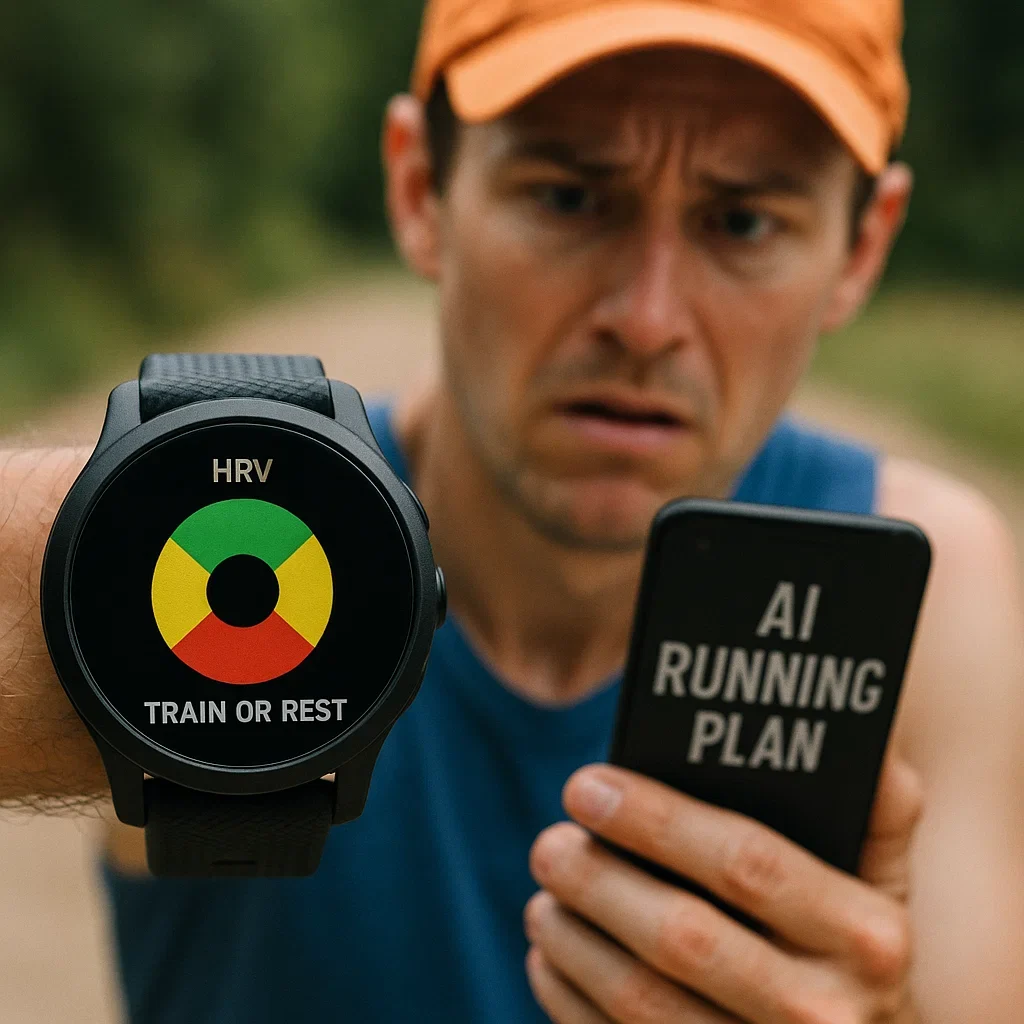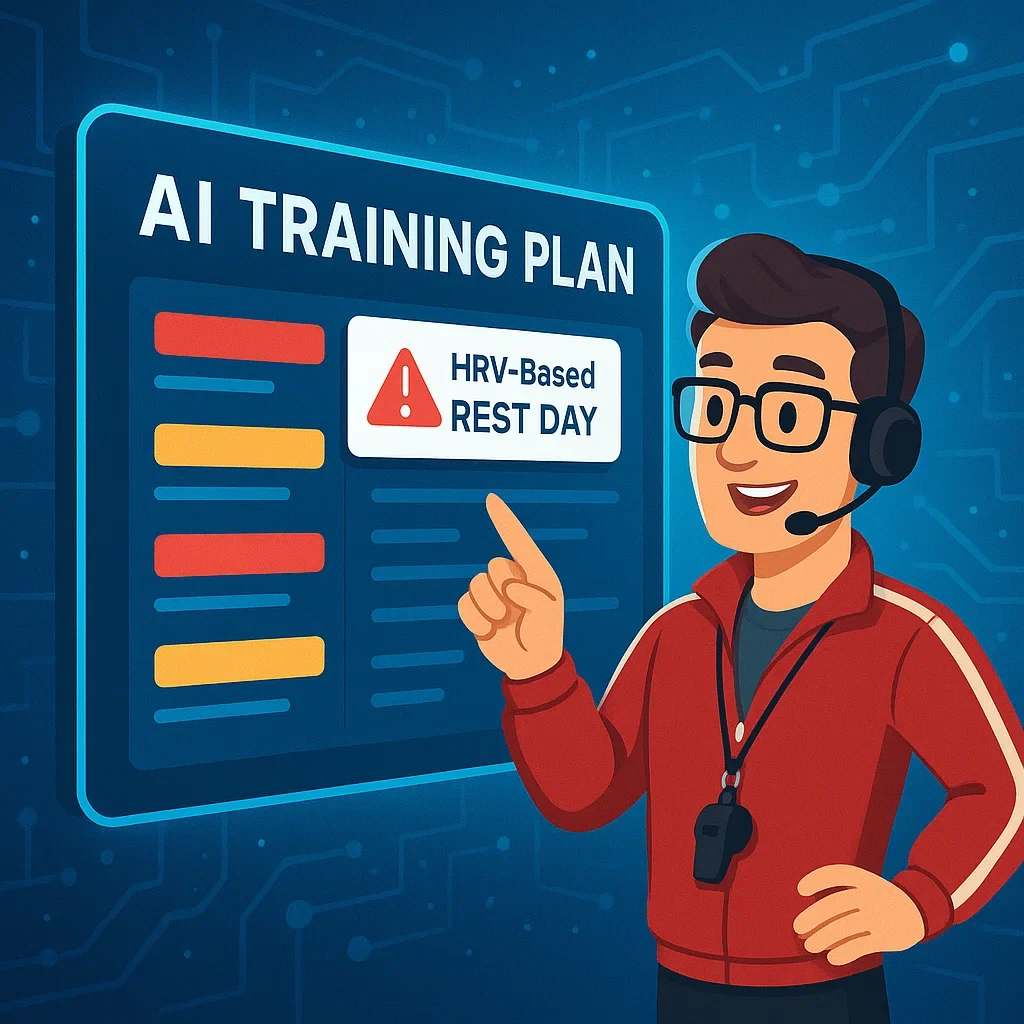Do AI Training Plans Cause Overload? Managing Rest with HRV ‘Traffic-Light’ Systems
Are you worried your new AI-powered training plan is pushing too hard? With so much tech promising “personalized” workouts, many runners ask: Does AI really prevent overtraining—or can it cause injury and burnout?
Enter HRV “traffic-light” systems: simple, science-backed alerts that help you rest smarter, train safer, and use AI without fear. In this guide, we’ll explore how HRV traffic lights work, why they matter for ultra and marathon runners, and how real athletes use them to stay healthy through hard training blocks.
We’ll cover the science, share real user stories, and give you practical tips for blending AI, HRV, and good old runner’s intuition—so you can train smarter, not just harder.
Ready? Let’s dig into AI overload, HRV traffic lights, and the new rules of recovery.
⚠️ What Is Training Overload in AI Running Plans?
🏃♂️When “Personalized” Isn’t Always Safer
Training overload happens when your body can’t recover from your workouts, leading to fatigue, injury, or burnout. Even the smartest AI plans can cause overload if the underlying data is incomplete, your lifestyle suddenly changes, or you push through warning signs.
With classic plans: Overload often comes from “one-size-fits-all” mileage, lack of adaptation, or ignoring fatigue cues.
With AI plans: Overload can happen if your feedback is inaccurate, wearables give false data, or the AI adapts too aggressively without enough rest days.
❗Common Signs of Overload
- Unusual, persistent fatigue or heavy legs
- New or recurring injuries (shin splints, plantar fasciitis, etc.)
- Declining motivation, poor sleep, or “dread” before sessions
- Plateauing or dropping performance, even with more effort
🚦 How HRV “Traffic-Light” Systems Work
💡HRV Basics: The Science in Simple Terms
HRV (Heart Rate Variability) measures the subtle changes between heartbeats—higher HRV often means better recovery and readiness to train, while lower HRV can signal fatigue or stress.
Many AI apps and smartwatches now use a simple “traffic-light” system to interpret your HRV score:
- Green light: Your body is ready—train as planned!
- Yellow light: Caution—consider a lighter session or extra rest
- Red light: Warning—your body needs recovery, best to skip or cross-train
📲How Apps Use HRV Traffic Lights
- Garmin, Polar, Whoop, Athletica.ai and others display a traffic light (or similar) each morning after you sync your HRV.
- Their AI coaches adapt your daily workout based on the color—sometimes automatically, sometimes with a “suggested change” pop-up.
- Ultra and marathon runners benefit most by using the yellow/red days for real recovery, not just “pushing through.”
💬 Real-World Experiences: “AI Plan Too Hard?” & HRV Traffic Light Stories
🛑 When AI Pushes Too Far
“I tried an AI plan for my first ultra. The plan kept ramping up mileage—even when I felt wrecked! Only realized I was on the edge when my HRV stayed red three days in a row.”
— Kyle, Reddit /r/ultrarunning
“Garmin Coach is cool, but it doesn’t always know when life stress or bad sleep hits. I ignored the HRV warning and got minor shin splints.”
— Maddy, Strava comment, 2025
🌱 How HRV Traffic Lights Saved My Training
“Athletica’s yellow days made me back off just in time—I skipped two hard sessions, then nailed my 50K. HRV makes the AI plan actually feel personalized.”
— Tessa, YouTube review
“I used to push through everything, but now if I see red in Whoop, I rest or just walk. I haven’t had a real injury in months.”
— Jordan, Strava Ultra Group
🔬 Science & Evidence: AI, HRV, and Recovery Monitoring
📖What the Research Says
- HRV-based training is scientifically supported: Studies (e.g., Plews et al., 2022; Buchheit et al., 2023) show that adjusting training based on daily HRV leads to better performance, fewer injuries, and more sustainable progress in endurance athletes.
- AI platforms are improving: Modern AI running plans now integrate HRV and other recovery signals for real-time plan adjustment. Early research shows these systems can reduce overtraining risk—if athletes follow the warnings!
- Limitations: No algorithm is perfect. Poor HRV data (bad sensor, illness, alcohol) or ignoring warnings can still lead to overload.
- Best practice: Combining AI guidance with HRV “traffic-light” alerts and honest self-assessment yields the safest results.
✅ Tips for Safe, Sustainable AI Training
- Check your HRV traffic light every morning. Use it as a “permission slip” to train hard, go easy, or rest. Trust the yellow and red days—even if your plan says otherwise.
- Sync your AI plan with real-world stress. Life stress, poor sleep, or illness can lower HRV even if training is steady. Tell your AI coach (manual input or feedback) when things feel off.
- Don’t ignore persistent fatigue or injury. If you see repeated yellow/red lights or feel drained for days, take a real break—even if your plan “adapts.”
- Use HRV trends, not just one-off scores. Watch for 3+ days in a row of yellow or red—this usually means you need more recovery.
- Combine tech with self-awareness. AI and HRV traffic lights work best when you also listen to your body, mood, and motivation.
- Ask for help if you’re unsure. Community forums, coaches, or fellow runners can provide a sanity check when the data gets confusing.

❓ FAQ: AI Overload & HRV Rest Management
🤖 Can AI training plans cause overtraining or injury?
🚦 How do HRV “traffic-light” systems work?
📱 Which apps use HRV traffic lights for rest management?
💡 Is HRV always accurate for training and recovery?
🔄 How should I adjust my AI plan if I get several yellow/red HRV days?
👀 How can I tell if my AI plan is too hard for me?
🌱 Should new runners use HRV and AI traffic lights?
📝 What’s the #1 rule for safe AI training and HRV use?
🏁 Conclusion & Recommendations: Smarter Rest, Safer AI Training
No app is perfect. Listen to your body, use the data wisely, and don’t let any algorithm override your common sense or well-being.
- Trust AI—up to a point: Let your plan guide you, but be ready to pause or pivot when your HRV traffic light flashes caution.
- Make recovery a priority: Rest is part of the plan—not a sign of weakness.
- Mix tech with intuition: The best results come from combining AI, HRV, and self-awareness.
📚 Further Reading & Resources
🏁 Final Thoughts: Run Smart, Rest Smarter
AI training plans and HRV “traffic-light” systems are revolutionizing recovery for runners at every level. Don’t be afraid to hit pause on hard sessions—rest days are part of progress, not a sign of weakness. With the right blend of data and self-awareness, you’ll run stronger, healthier, and longer.
Got questions about AI overload or HRV? Tried a new system and want to share your wins (or struggles)? Join the conversation below—your experience might help someone else find the perfect balance.
Has HRV or an AI plan helped you avoid injury—or did it miss a warning sign? Share your experience, ask questions, or offer your best recovery advice below. Your story could help fellow runners stay healthy and motivated!

About the Author
Lost Pace is an ultramarathon runner, shoe-tester and the founder of umit.net. Based year-round in Türkiye’s rugged Kaçkar Mountains, he has logged 10,000 + km of technical trail running and completed multiple 50 K–100 K ultras.
Blending mountain grit with data, Lost analyses power (CP 300 W), HRV and nutrition to craft evidence-backed training plans. He has co-written 260 + long-form guides on footwear science, recovery and endurance nutrition, and is a regular beta-tester of AI-driven coaching tools.
When he isn’t chasing PRs or testing midsoles, you’ll find him sharing peer-reviewed research in plain English to help runners train smarter, stay healthier and finish stronger.
Ultrarunner · Data geek · Vegan athlete

